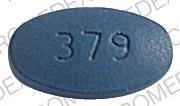Trovafloxacin Dosage
Applies to the following strengths: 100 mg; 200 mg; 5 mg/mL
Usual Adult Dose for:
- Intraabdominal Infection
- Nosocomial Pneumonia
- Pelvic Infections
- Pneumonia
- Skin and Structure Infection
Additional dosage information:
Usual Adult Dose for Intraabdominal Infection
Complicated: 300 mg IV followed 24 hours later by 200 mg orally every day for 7 to 14 days.
Usual Adult Dose for Nosocomial Pneumonia
300 mg IV once, followed 24 hours later by 200 mg orally once a day for 10 to 14 days.
Usual Adult Dose for Pelvic Infections
Initial dose: 300 mg IV every 24 hours during the acute phase of infection. Change to oral therapy as soon as clinical conditions permit.
Maintenance dose: 200 mg orally every 24 hours for a total course of 14 days.
Usual Adult Dose for Pneumonia
Community-acquired: 200 mg oral or IV once, followed 24 hours later by 200 mg orally once a day for 7 to 14 days.
Usual Adult Dose for Skin and Structure Infection
200 mg (oral or IV) followed by 200 mg orally every day for 10 to 14 days.
Liver Dose Adjustments
Patients with mild/moderate (Child-Pugh class A/B) cirrhosis:
If dose in patients with normal hepatic clearance is 300 mg IV, administer 200 mg IV every 24 hours to cirrhotic patients.
If dose in patients with normal hepatic clearance is 200 mg (oral or IV), administer 100 mg (oral or IV) every 24 hours to cirrhotic patients.
Precautions
Trovafloxacin has been associated with severe hepatic injury, including acute liver failure). A duration of therapy longer than 2 weeks and reexposure may significantly increase the risk of liver injury. Liver function tests should be monitored in patients who develop signs of hepatitis and discontinuation of therapy should be considered.
Trovafloxacin has been restricted by the FDA to patients meeting the following criteria: Patients having a life- or limb-threatening infection such as nosocomial pneumonia or complicated intra-abdominal infection; hospitalized or long-term care patients; patients for whom the physician believes the benefit of trovafloxacin outweighs the potential risk of liver toxicity. The majority of patients meeting these criteria would most likely require intravenous trovafloxacin. However, it should not be used if safer alternatives may be effective. The distribution of trovafloxacin is restricted to hospitals and long-term nursing care facilities.
Patients should avoid direct or indirect exposure to sunlight and artificial UV light during and for several days after treatment. The drug should be discontinued if signs of phototoxicity occur (e.g., sunburn, redness, burning, itching, rash, blistering).
Alatrofloxacin has been associated with life-threatening hypotension, even when infused at recommended rates. The drug should be infused over at least 60 minutes and blood pressure should be monitored closely during the infusion.
May cause dizziness or lightheadedness. Patients should be advised to avoid driving or engaging in other tasks requiring mental alertness and coordination until they know how the drug affects them.
The drug should be discontinued if pain, inflammation, or rupture of a tendon occurs.
The safety and effectiveness of trovafloxacin in pediatric patients less than 18 years have not been established. An increased incidence of osteochondrosis and arthropathy has been reported in studies with juvenile animals.
Other Comments
Oral trovafloxacin should be administered at least 2 hours before or after iron-, zinc-, aluminum-, or magnesium-containing compounds (e.g., antacids, sucralfate, mineral supplements, buffered didanosine).
More about trovafloxacin
- Check interactions
- Compare alternatives
- Side effects
- Dosage information
- During pregnancy
- Drug class: quinolones and fluoroquinolones
- Breastfeeding
Professional resources
Other brands
Related treatment guides
Further information
Always consult your healthcare provider to ensure the information displayed on this page applies to your personal circumstances.


